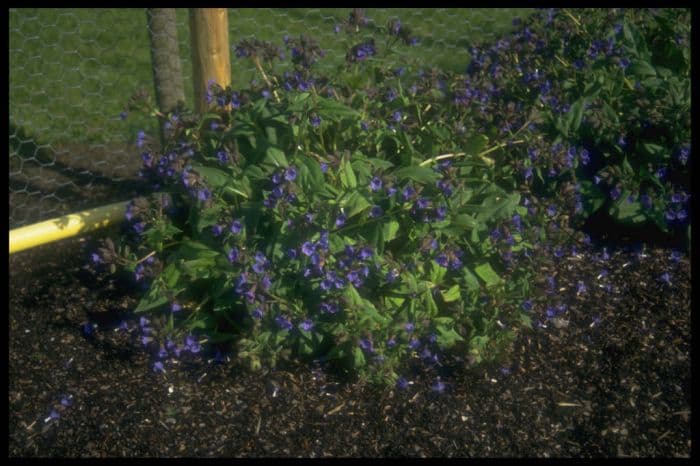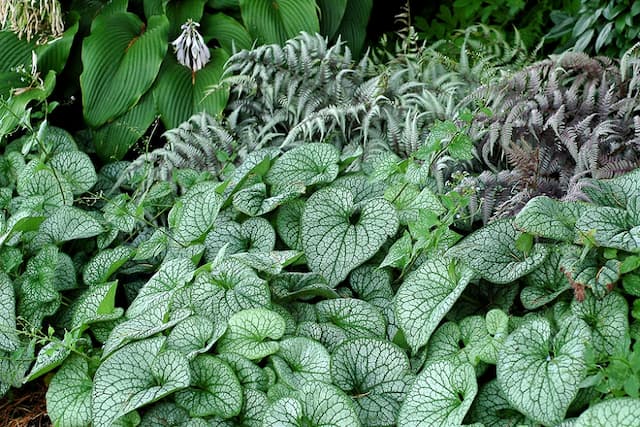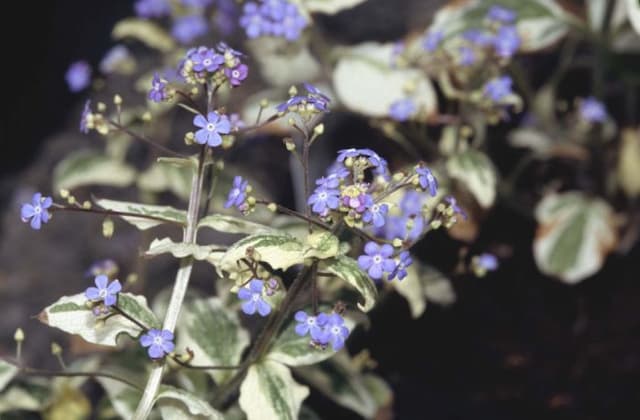Lungwort Pulmonaria 'Blue Ensign'

ABOUT
Pulmonaria 'Blue Ensign', commonly known as the lungwort, is a perennial plant valued for its early spring blooms and decorative foliage. Lungworts characteristically have a clumping growth habit with broad, fuzzy leaves. The leaves of 'Blue Ensign' are particularly noted for their solid green color, without the white spots or mottling that can be found on the leaves of other lungwort varieties. The flowers of lungwort are truly striking. 'Blue Ensign' stands out with its vivid blue blossoms that emerge from pinkish buds. As the bell-shaped flowers mature, they create a charming display that can be a true highlight in a shade garden during their blooming season. The flowers are arranged on stems that rise above the foliage, bringing vivid color to the plant's overall appearance. The contrast between the bright blue flowers and rich green leaves creates a pleasing visual effect in garden settings, especially when planted in masses or along borders where their beauty can be appreciated up close.
About this plant
 Names
NamesFamily
Boraginaceae.
Synonyms
Lungwort, Bethlehem Sage, Soldiers and Sailors.
Common names
Pulmonaria angustifolia 'Blue Ensign'
 Toxicity
ToxicityTo humans
Lungwort, specifically Pulmonaria 'Blue Ensign', is generally considered non-toxic to humans. There are no well-documented cases of poisoning from ingesting this plant, and it is not typically associated with adverse effects. However, as with any plant, individual allergic reactions or sensitivities can occur, so it is always wise to exercise caution and not consume plant material that is not commonly recognized as food.
To pets
Lungwort, specifically Pulmonaria 'Blue Ensign', is also generally considered non-toxic to pets. There is no evidence to suggest that it poses a significant risk of poisoning to animals such as cats and dogs. As with humans, it is still advisable to discourage pets from ingesting plants, as individual animals may have different sensitivities or allergic reactions.
 Characteristics
CharacteristicsLife cycle
Perennials
Foliage type
Semi-deciduous
Color of leaves
Green
Flower color
Blue
Height
1 foot (30 cm)
Spread
1 foot 2 inches (35 cm)
Plant type
Herb
Hardiness zones
4
Native area
Europe
Benefits
 General Benefits
General Benefits- Shade Tolerance: Thrives in shady areas where other plants might struggle to grow.
- Attracts Pollinators: Entices bees and butterflies, supporting biodiversity.
- Early Bloomer: Produces flowers in early spring, adding early color to gardens.
- Low Maintenance: Requires minimal care once established, making it ideal for busy gardeners.
- Drought Resistant: Tolerant of dry soil conditions once established.
- Ground Cover: Spreads effectively, which can help suppress weeds.
- Ornamental Value: Offers vibrant blue flowers and attractive foliage for aesthetic appeal.
- Cold Hardy: Capable of withstanding cold temperatures and frost.
- Non-Invasive: Unlike some plants, it does not aggressively take over the garden.
 Medical Properties
Medical PropertiesThis plant is not used for medical purposes.
 Air-purifying Qualities
Air-purifying QualitiesThis plant is not specifically known for air purifying qualities.
 Other Uses
Other Uses- Pulmonaria 'Blue Ensign', commonly known as Lungwort, can be used as natural dye for fabrics, providing a range of colors from green to brown depending on the mordant used.
- The rough texture of Lungwort leaves makes for an interesting addition to tactile sensory gardens, particularly for educational purposes to help children and visually impaired individuals to experience varied plant textures.
- Lungwort leaves can be used in compost piles, where their high nitrogen content helps to accelerate the composting process of organic matter.
- The plant has been used traditionally to line nests as its leaves are somewhat borage-like and may deter pests due to their hairy texture.
- Lungwort can be planted under fruit trees where it will not only add visual interest but also help to maintain soil moisture and suppress weeds.
- Leafy branches of Lungwort may be used in floral arrangements to provide a verdant backdrop for more colorful blossoms due to their unique spotted foliage.
- The plant can serve as an indicator for pH levels in the soil, thriving in more alkaline conditions and alerting gardeners to soil conditions that may be unsuitable for other plants.
- Gardeners can use Lungwort as ground cover to minimize erosion on sloped areas due to its spreading form which helps stabilize the soil.
- In a wildlife garden, Lungwort can provide early nectar for pollinators such as bees and butterflies emerging in the spring.
- Lungwort's leaves can be used as a natural mulch around other plants to help retain moisture in the ground and add organic matter to the soil as they decompose.
Interesting Facts
 Feng Shui
Feng ShuiThe Lungwort is not used in Feng Shui practice.
 Zodiac Sign Compitability
Zodiac Sign CompitabilityThe Lungwort is not used in astrology practice.
 Plant Symbolism
Plant Symbolism- Resilience and Tenacity: Pulmonaria, also known as Lungwort, due to its ability to thrive in varying conditions and its rough, hairy leaves which gives it a resilient appearance.
- Health and Healing: Historically, Lungwort has been associated with treating lung infections based on the doctrine of signatures, due to its lung-shaped leaves.
- Hope and Restoration: Its early spring blooms and the transformation of its flowers from pink to blue symbolize hope and the renewal associated with the changing of seasons.
- Uniqueness and Individuality: The spotted or mottled leaves of the Lungwort are unique to each plant, symbolizing the idea of each individual's unique traits and beauty.
 Water
WaterLungwort should be watered deeply and thoroughly to ensure the soil is moist, especially during spring and summer when the plant is actively growing. Check the soil moisture and water approximately once a week, though this may vary depending on climate conditions such as heat and humidity. It typically needs about 1 inch of water per week, whether from rainfall or manual watering. During hot, dry periods, increase the frequency to prevent the soil from drying out completely, but always avoid overwatering as this can lead to root rot. In the winter, reduce watering as the plant enters dormancy and requires less moisture.
 Light
LightLungwort prefers partial shade to full shade, thriving under the dappled light beneath larger plants or trees. Avoid placing it in full sun, as the leaves can become scorched and lose their vibrant colors. The best spot would be a north-facing garden or an area that receives morning sunlight with afternoon shade to protect it during the hottest part of the day.
 Temperature
TemperatureLungwort is hardy and can tolerate a wide range of temperatures, with an ideal growing range between 50°F to 75°F. It can survive minimum winter temperatures down to -20°F when properly mulched and established. During the summer months, it is essential to ensure that the plant does not overheat, especially when the temperatures climb over 80°F, as heat stress can damage the plant.
 Pruning
PruningLungwort should be pruned to remove any damaged or spent leaves and to promote bushier growth. The best time for pruning is immediately after flowering, usually in late spring or early summer. Cut back the flower stems and any old foliage to encourage fresh leaves to develop. Pruning annually helps maintain the plant's health and appearance.
 Cleaning
CleaningAs needed
 Soil
SoilThe best soil mix for Lungwort (Pulmonaria 'Blue Ensign') is well-draining soil enriched with compost or other organic matter, with a pH range of 6.0 to 7.0 for optimal growth.
 Repotting
RepottingLungwort usually does not require frequent repotting and can be repotted every 3-4 years, or when it has clearly outgrown its current container.
 Humidity & Misting
Humidity & MistingLungwort thrives in a environment with average to high humidity levels but is quite adaptable and does not require specific humidity conditions.
 Suitable locations
Suitable locationsIndoor
Place Lungwort in bright, indirect light and moist, rich soil.
Outdoor
Plant Lungwort in partial shade with moist, well-draining soil.
Hardiness zone
3-8 USDA
 Life cycle
Life cyclePulmonaria 'Blue Ensign', commonly known as Lungwort, begins its life cycle as a seed, which germinates in moist soil in spring. Seedlings develop into rosettes of basal leaves that are often spotted or mottled, characteristic of many Pulmonaria species. As the plant matures, it develops flowering stems in early to mid-spring, showcasing clusters of funnel-shaped blue flowers that are attractive to pollinators. After flowering, the plant sets seed, which can self-sow in ideal conditions, perpetuating the life cycle. Throughout the summer, Lungwort enters a vegetative stage, focusing on leaf growth and energy accumulation. With the onset of colder weather in autumn, the plant's foliage may die back, and it enters a period of dormancy over the winter, only to resprout with new growth the following spring.
 Propogation
PropogationPropogation time
Spring
Pulmonaria 'Blue Ensign', commonly known as Lungwort, can be propagated using several methods, but division is the most popular and effective. The best time for division is in the early spring or after the flowering season in late spring to early summer when the plant is not in active bloom. To propagate by division, carefully lift the entire plant from the ground and gently tease apart the clumps into smaller sections, making sure each section has a good amount of roots. These sections can then be planted directly into their new locations in the garden, spaced approximately 12 inches (30 centimeters) apart to allow for growth. Water the new divisions well to help establish them.









